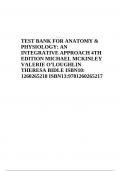..........
TEST BANK FOR ANATOMY &
PHYSIOLOGY: AN
INTEGRATIVE APPROACH 4TH
EDITION MICHAEL MCKINLEY
VALERIE O’LOUGHLIN
THERESA BIDLE ISBN10:
1260265218 ISBN13:9781260265217
,Test Bank for Anatomy & Physiology: An Integrative Approach, 4th Edition, Michael
McKinley, Valerie O’Loughlin, Theresa Bidle, ISBN10: 1260265218, ISBN13:
9781260265217
Table of Contents
1. The Sciences of Anatomy and Physiology
2. Atoms, Ions, and Molecules
3. Energy, Chemical Reactions, and Cellular Respiration
4. Biology of the Cell
5. Tissue Organization
6. Integumentary System
7. Skeletal System: Bone Structure and Function
8. Skeletal System: Axial and Appendicular Skeleton
9. Skeletal System: Articulations
10. Muscle Tissue
11. Muscular System: Axial and Appendicular Muscles
12. Nervous System: Nervous Tissue
13. Nervous System: Brain and Cranial Nerves
14. Nervous System: Spinal Cord and Spinal Nerves
15. Nervous System: Autonomic Nervous System
16. Nervous System: Senses
17. Endocrine System
18. Cardiovascular System: Blood
19. Cardiovascular System: Heart
20. Cardiovascular System: Vessels and Circulation
21. Lymphatic System
22. The Immune System and the Body’s Defense
23. Respiratory System
24. Urinary System
25. Fluid and Electrolytes
26. Digestive System
27. Nutrition and Metabolism
28. Reproductive System
29. Development,Pregnancy, and Heredity
,Chapter 01 The Sciences of Anatomy and Physiology
Multiple choice:
1) If a scientist forms and tests a hypothesis, but gets unexpected results, what is a logical
next step? Check all that apply.
A) Accept the original hypothesis
B) Reject the original hypothesis
C) Revise the original hypothesis
D) Design a new experiment based on a new or modified hypothesis.
2) Some researchers think pheromones are important tools in human communication.
Pheromones are chemical signals that one individual sends to another. What research questions
might be asked by anatomists, and what questions might be asked by physiologists, to determine
if pheromones are important to humans?
3) Iron atoms help our blood transport oxygen. Describe each level of anatomical structural
complexity for an iron atom in your blood, working from the simplest level (atom) to the most
complex (organism).
, 4) If someone speaks too loudly into a microphone, a public address system will sometimes
produce a loud whistle of amplified feedback. Explain whether this is an example of negative or
positive feedback, and explain how the microphone, control box,and speaker of the system serve
as the different components of a feedback loop.
5) The discipline known as anatomy examines similarities and differences
across species.
6) The discipline that studies the functions of the nervous system, including the way that
impulses are conducted, is known as .
7) The discipline that associates changes in organ system function with disease or injury is
known as .
8) The group of metabolic reactions in which smaller molecules are combined to form larger
ones is .
9) Specialized subunits of cells that are made of macromolecules are called _ .





